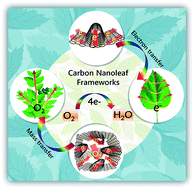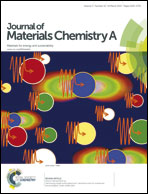Rational design of three-dimensional nitrogen-doped carbon nanoleaf networks for high-performance oxygen reduction†
Abstract
The application of conventional nanostructure carbon-based materials (such as graphene and carbon nanotubes (CNTs)) as catalysts for the oxygen reduction reaction always suffers from inferior conductivity and low surface area because both graphene and CNTs easily aggregate to form networks with many boundaries. Here, to solve those problems, we have rationally developed “carbon nanoleaf” networks for the oxygen reduction reaction of fuel cells. The “carbon nanoleaf” networks are constructed as aerogels with nitrogen-doped CNTs bridged with graphene nanoribbons (GNRs) by using CNTs as a single precursor. In these carbon nanoleaves, large amounts of unzipped nanoscale GNRs tightly attach to the intact inner walls of the CNTs and thus allow intrinsically good electrical contact. Self-assembly of the carbon nanoleaves into three-dimensional porous aerogel networks with large surface areas guarantees the ultrafast and sufficient mass transfer in the catalytic process. Moreover, the “carbon nanoleaf” networks restrain the aggregation of adjacent CNTs or GNRs, which is inevitable in other 3D CNT and/or graphene nanosheet/GNR networks, to reduce the possibility of the formation of boundaries. Accordingly, the prepared 3D carbon nanoleaf architectures possess a large surface area (380–497 m2 g−1) and an excellent conductivity (up to 112 S m−1), much higher than those of other reported 3D carbon-based architectures. The “carbon nanoleaf” networks can thus act as newly developed oxygen reduction reaction electrocatalysts with a positive onset potential, ultra-low hydrogen peroxide production and excellent durability that are comparable to or better than those of commercial Pt/C catalysts both in alkaline and acidic solutions.


 Please wait while we load your content...
Please wait while we load your content...